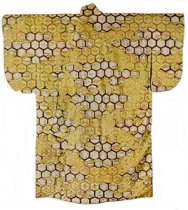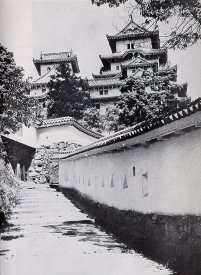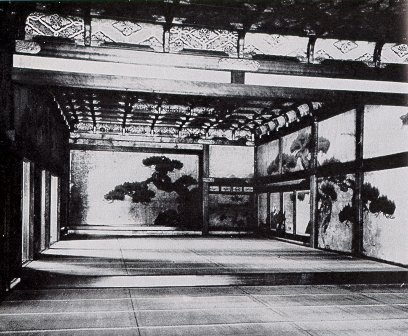
Momoyama Era: 1587-1603
As the power of the Muromachi Shogunate faded various daimyo continued their power struggles. If someone had enough As the power of the Muromachi Shogunate faded various daimyo continued their power struggles. If someone had enough power and coupled occupy Kyoto he could declare himself the new shogun. Daimyos themselves were sometimes assassinated by those under them who wanted their position. Concepts of loyalty and honesty vanished as the grab for power escalated.
In the middle of the 16th century (1568) Oda Nobunga conquered a number of the daimyo and was in the process of trying to unify the nation when he was assassinated (1582). He had managed, though, to unite about half of the provinces of Japan and began the movement to disarm the peasantry.
Nobunga was hostile towards the Buddhist temples since they had opposed his rise to power. In 1571 his forces attacked Hiei-san, a holy place of Japanese Buddhism. The result was all three thousand of the buildings of the monastery destroyed and thousands of monks and other people working there killed. The land was confiscated and a fort was later built on the same area.The two successors of Nobunga were both brilliant, however. Toyotomi Hideyoshi unified Japan but didn't become the shogun.

Hideyoshi
Hideyoshi died in 1598 leaving his son, Toyotomi Hideyori, as his successor. Ishida Mitsumari, the leader of the Hideyoshi bureaucracy, was loyal to Hideyori but Tokugawa Ieyasu wasn't.

An uchikake from the Momoyama era
Ieyasu saw a chance to get power and gathered various discontented warlords under him. Mitsunari and Ieyasu had what is termed the greatest battle in Japanese history at Sekigahara. Mitsunari's army was called the West Army, and Ieyasu's the East Army.
The West Army outnumbered the East Army, but Ieyasu had bribed some of the daimyo under Mitsunari and they did not join the attack, allowing Ieyasu to win the battle. Mitsunari was captured and executed. This then firmly established Ieyasu as the new shogun, starting the Tokugawa Shogunate.
The period of time when the civil wars died down and culture had a chance to once again flourish is referred to as the Azuchi Momoyama Era.
Not all was bad, though. The daimyo encouraged new developments in rice growing, flood control and an expansion of the merchant class. Iron refining was invented and the overall wealth of the country increased.
As far as architecture goes, the period is known for its huge fortress-castles built by all three men. None of the castles still exists in their entirety, though. Some parts of Hideyoshi's castles were removed to temples.

Himeji Castle in Hyogo Prefecture from the Momoyama era
Particular dates of importance
1586: Toyotomi Hideyoshi becomes Grand Minister
1588: Hideyoshi confiscates swords from the people and defines fixed social classes
1590: Hideyoshi completes reunification of Japan. He orders the taking of a census. This is done to determine what type of support armies could be given by specific areas of Japan; this lead to a ruling where farmers could not leave their land.
1590: Ieyasu transfers his domain to the Kanto region and starts the construction of Edo Castle.
1591: A decree was issued ordering craftsmen and merchants to live in towns; they could no longer live in villages. The main goal was to make sure that the social order was stratified along strict lines.
1592: Hideyoshi resigns the regency. Japanese invasion of Korea. Invasion fails largely due to lack of Japanese naval forces.
1593: Mind ambassadors arrive in Japan to negotiate withdrawal from Korea.
1596: Hideyoshi becomes Regent.
1597-1598: Hideyoshi expels Christian missionaries and starts a military campaign against Korea. The effort was fairly quickly abandoned.
1597: Second Japanese invasion of Korea.
1597: Hideyoshi begins persecution of Christians.
1598: Hideyoshi's death.
1600: Battle of Sekigahara. Ieyasu takes command of 87 estates and divides them among his followers. He takes control of Kyoto and, therefore, the Emperor.
1600: William Adams, the first Englishman to visit Japan, become shipbuilding advisor to the Shogun after landing in Japan on his Dutch ship the Liefde. Many of the events in the tv series and book Shogun are based on reality. Anjin-san, as Adams is known in the movie and book, did become an advisor to Ieyasu. He was made a samurai and was given the rank of hatamoto, which meant that he had person access to the supreme ruler of the country. No other foreigner in history received such an honor, before or since. He acquired a sizable estate and a Japanese wife. He built the first western-style ships in Japan and is considered to be the founder of Japan's navy.
1603: The first performances of kabuki take place in a Kyoto theater. Tokugawa Ieyasu adopts title of Shogun.

Audience Hall at Nijo Castle in Kyoto from the Momoyama era
|